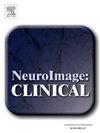Altered self-processing brain networks in paediatric functional neurological disorder
IF 3.6
2区 医学
Q2 NEUROIMAGING
引用次数: 0
Abstract
Objectives
Functional neurological disorder (FND) is associated with altered self-processing – the neural processes that underpin the individual’s self-agency and sense of self. This study used resting-state functional magnetic resonance imaging to examine three nested meta-analytically defined self-processing brain networks in 28 children with mixed FND symptoms and 31 healthy controls.
Methods
Regions of interest (ROIs) for each layer of brain network analysis were defined using the nested hierarchical model of self-processing developed by Northoff and colleagues specifying the insula (interoceptive processing), temporoparietal junction [TPJ] (exteroceptive processing), and anterior medial prefrontal cortex [amPFC] (mental-self processing) as seed ROIs. Connectivity differences for each layer of self-processing were examined with ROI-to-ROI analysis. Correlation analyses were conducted in relation to adverse childhood experiences (ACEs) and arousal (resting heart rate).
Results
At the mental-self layer, children with FND (vs. controls) had increased functional connectivity between the amPFC and thalamus and left dorsolateral prefrontal cortex (dlPFC). Children with functional seizures (vs. other FND symptoms) had decreased functional connectivity between the amPFC and right TPJ. At the interoceptive layer, the FND group showed a positive correlation between ACEs and functional connectivity between the left insula seed and right TPJ and dorsal anterior cingulate cortex (dACC). There were no findings at the exteroceptive layer of self-processing.
Conclusions
Our findings suggest that ACEs (including trauma) are associated with altered self-processing in brain networks in children with FND. Further examination of self-processing is likely to prove a fruitful endeavour both in therapy and in future FND research.
儿童功能性神经障碍的自我处理脑网络改变
目的功能性神经障碍(FND)与自我处理的改变有关,自我处理是支撑个体自我代理和自我意识的神经过程。本研究使用静息状态功能磁共振成像检查了28名患有混合性FND症状的儿童和31名健康对照者的三个嵌套的meta分析定义的自我加工脑网络。方法使用Northoff及其同事开发的自我加工的嵌套分层模型定义每一层脑网络分析的兴趣区域(roi),将脑岛(内感受加工)、颞顶连接(外感受加工)和前额叶前部内侧皮层(心理自我加工)作为种子roi。用ROI-to-ROI分析来检验每一层自我加工的连通性差异。对不良童年经历(ace)和觉醒(静息心率)进行相关分析。结果在心理自我层,FND患儿(与对照组相比)amPFC与丘脑和左背外侧前额叶皮层(dlPFC)之间的功能连通性增加。与其他FND症状相比,功能性癫痫发作的儿童amPFC和右侧TPJ之间的功能连通性下降。在感受层,FND组显示ace与左岛核、右TPJ和前扣带背皮层(dACC)之间的功能连接呈正相关。在自我加工的外感受层没有发现。结论:我们的研究结果表明,不良经历(包括创伤)与FND儿童大脑网络自我加工的改变有关。对自我加工的进一步研究很可能在治疗和未来的FND研究中证明是一项卓有成效的努力。
本文章由计算机程序翻译,如有差异,请以英文原文为准。
求助全文
约1分钟内获得全文
求助全文
来源期刊

Neuroimage-Clinical
NEUROIMAGING-
CiteScore
7.50
自引率
4.80%
发文量
368
审稿时长
52 days
期刊介绍:
NeuroImage: Clinical, a journal of diseases, disorders and syndromes involving the Nervous System, provides a vehicle for communicating important advances in the study of abnormal structure-function relationships of the human nervous system based on imaging.
The focus of NeuroImage: Clinical is on defining changes to the brain associated with primary neurologic and psychiatric diseases and disorders of the nervous system as well as behavioral syndromes and developmental conditions. The main criterion for judging papers is the extent of scientific advancement in the understanding of the pathophysiologic mechanisms of diseases and disorders, in identification of functional models that link clinical signs and symptoms with brain function and in the creation of image based tools applicable to a broad range of clinical needs including diagnosis, monitoring and tracking of illness, predicting therapeutic response and development of new treatments. Papers dealing with structure and function in animal models will also be considered if they reveal mechanisms that can be readily translated to human conditions.
 求助内容:
求助内容: 应助结果提醒方式:
应助结果提醒方式:


